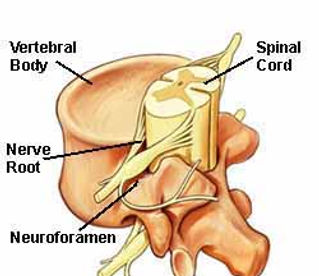MALAYSIAN SPINAL INJURIES ASSOCIATION
PERSATUAN KECEDERAAN SPINA MALAYSIA

Spinal Cord Injury
Some basic questions and answers...
Anatomy of a Spinal Cord Injury
The spinal cord is the central part of the communication system between the brain and body. It is flexible, nearly an inch in diameter at its widest point, and 18 inches long. It starts below the base of the brain (in the neck, also known as the cervical spine) and extends downward, ending near the waist or low back (lumbar spine). The spinal cord and nerve roots comprise the central nervous system.
The central nervous system enables the body to move (motor nerves) and feel (sensory nerves). In the brain, there are 12 cranial (skull) nerves. Five are motor, three are sensory, and four are motor / sensory.
Thirty-one pairs of nerve roots branch off the spinal cord and go beyond the spinal column to enable the body to move and feel. These nerves form the peripheral nervous system.
Spinal Level Pairs of Spinal Nerves
Cervical 8
Thoracic 12
Lumbar 5
Sacral 5
Coccyx (tailbone) 1
Three sheaths or membranes (meninges) surround and protect the spinal cord. Cerebrospinal fluid, a clear body fluid, circulates between the meninges, brain, and spinal cord. The brain and spinal cord float in this protective fluid. The three meninges are:
Three sheaths or membranes (meninges) surround and protect the spinal cord. Cerebrospinal fluid, a clear body fluid, circulates between the meninges, brain, and spinal cord. The brain and spinal cord float in this protective fluid. The three meninges are:
- Dura mater: gray outer layer of the spinal cord and nerve roots. It is made of strong connective tissue.
- Arachnoid membrane: resembles a loosely woven fabric of arteries and veins. This layer is thinner than the dura mater.
- Pia mater: innermost layer, a delicate and highly vascular (that means that blood goes to this layer) membrane that provides blood to the spinal cord and nerve roots.
The design of the spine's vertebrae creates a hollow in the middle of the spinal column. The spinal cord rests in this protective bony environment.
For spinal cord injury, it's particularly important to understand the autonomic nervous system. This system of nerves sends sensory impulses to the brain from the arteries, heart, lungs, and organs in the abdomen and pelvis. These involuntary impulses occur without your conscious knowledge. The autonomic nerves affect such reactions as reflexes and the body's response to temperature changes.
There are two types of autonomic nerves: sympathetic and parasympathetic.
- Sympathetic system: responds to stress and prepares the body for action
- Parasympathetic system: works while the body is at rest
Autonomic nerves influence involuntary body processes such as breathing, heartbeat, digestion, and blood pressure. The autonomic nervous system works to maintain the body's homeostasis, or stable internal environment. When a spinal cord injury disrupts one or more of these involuntary body processes, the outcome can be life-altering.


Symptoms of a Spinal Cord Injury
Spinal cord injury (SCI) symptoms vary depending on the cause and location of the SCI. Spinal cord injury is much more than damage to the spinal cord. SCI can affect the body's movement, sensation, and organ function.
It's important to remember that SCI symptoms vary from case to case. A relatively mild spine cord injury may cause a few symptoms that resolve over time. Even severe cases of SCI don't all have the same symptoms, and over time, those symptoms may lessen.
You can read the list below for possible symptoms associated with SCI:
- Inability to breathe without assistance
- Loss of bowel /bladder control
- Inability to regulate body temperature, blood pressure
- Blood clots
- Infections
- Pain
- Spastic contractions (exaggerated movements)
- Loss of muscle control and muscle mass (muscle atrophy)
- Loss of sensation (cannot feel temperature, pressure, pain)
- Inability to sense body position
- Calcium deposits in the muscles and tendons
- Infertility (males)
- Sexual dysfunction
- Pressure ulcers (i.e., bed sores)
Paralysis is a common symptom related to SCI. The types of paralysis associated with a spinal cord injury are:
- Tetraplegia (Quadriplegia) occurs when the cervical (neck) area of the spinal cord is injured. Christopher Reeve had this type of paralysis. Quadriplegics, also known as tetraplegics, cannot move their arms or legs.
- Paraplegia occurs when the spinal cord is damaged below the cervical spine. It may be injured in the thoracic spine (mid-back), or lumbar (low back). Although the spinal cord ends at L2, cord injury is possible at the end tip (conus) of the spinal cord and can involve the cauda equina. The cauda equina is a bunch of spinal nerves resembling a horse's tail.

